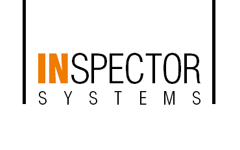Pipe robots from INSPECTOR SYSTEMS have been especially developed for the inspection and maintenance of the interior of pipe systems.
Their construction allows the robots to work in long lengths of pipes, which include many bends, and vertical sections of piping.
The robots are made up of multiple drive units and a head module (i.e. inspections or grinding elements), all of which are joined together with flexible, folding bellows. The wheels of the drive units can be pneumatically pressed to perfectly grip the interior walls of the pipe. This means that even vertical sections of pipe can be traveled.
Robots for Video Inspection
Robots deployed for the video inspection of pipe systems possess a maneuverable head that can be turned 360° and tilted 90°. This means that even video pictures can be shot right below the pipe wall.
Separate video recording of on-line video data at the control point allows the operator to monitor, achieve and add comments to the footage.
The camera has been specially designed for use within pipe systems and has not only great resolution but also a 10x optical zoom function as well as automatic and manual focusing and adjustable lighting.
Robots for carrying out inspections on pipe systems
Over the years INSPECTOR SYSTEMS has developed many different types of robots for the inspection of pipe systems.
These include crawler with ultrasonic and eddy current capabilities which can measure the thickness of pipe walls as well as making interior checks on welding seams. A robot which makes use of electrodes for inspecting the interior of rubber coated pipe systems has also been developed and constructed.
Milling Robots
Robots with milling capabilities can be used wherever grooves need to be cut in the interior of pipe sections. These robots can also work in a point by point manner.
The milling tools can cut out a predetermined shape with an exactness of within 1/10 of a millimeter. They can be made to fit the pipes geometry depending of course on the desired usage and due to their integration with the drive units, can work along every point of a pipe section.
Grinding Robots
Welding joints on one side of a pipe can be inspected by using ultrasound, eddy current and dye penetration techniques. These inspections should be repeated regularly during routine maintenance and system shut downs.
Inspection results can be severely affected by the presence of root welds on the inner side of the pipe wall, because they can often be confused with damage to the pipe wall.
By using a robot equipped with grinding tools, root welds can be easily removed so that accurate inspection results can be obtained. Removing the root welds leads to an improvement of the interior of the pipe wall.

